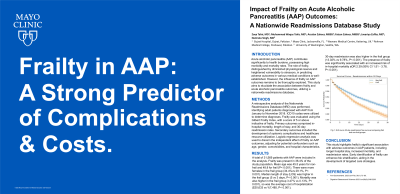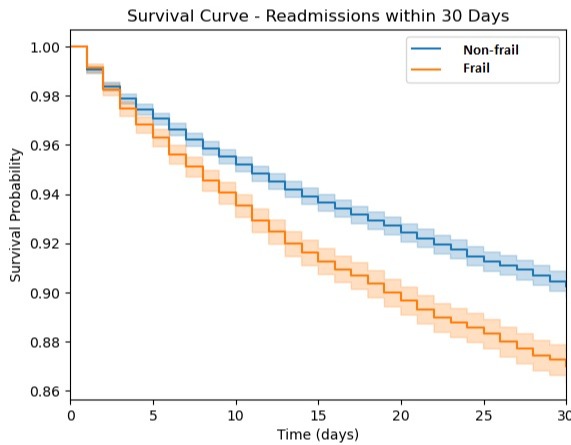Sunday Poster Session
Category: Biliary/Pancreas
P0033 - Impact of Frailty on Acute Alcoholic Pancreatitis Outcomes: A Nationwide Readmissions Database Study
Sunday, October 22, 2023
3:30 PM - 7:00 PM PT
Location: Exhibit Hall

- MT
Muhammad Waqas Tahir, MD
Mayo Clinic Florida
Jacksonville, FL
Presenting Author(s)
Zoya Tahir, MD1, Muhammad Waqas Tahir, MD2, Arsalan Zaheer, MBBS3, Faizan Zaheer, MBBS4, Javariya Zaffar, MD5, Namrata Singh, MD6
1Gujrat Hospital, Bear, DE; 2Mayo Clinic Florida, Jacksonville, FL; 3Kettering General Hospital, Kettering, England, United Kingdom; 4Fatima Memorial Hospital, Lahore, Punjab, Pakistan; 5Rehman Medical College, Jacksonville, FL; 6University of Washington Medical Center, Seattle, WA
Introduction: Acute alcoholic pancreatitis (AAP) contributes significantly to health burdens, possessing high morbidity and mortality rates. The role of frailty, distinguished by diminished physiological reserve and heightened vulnerability to stressors, in predicting adverse outcomes in various medical conditions is well-established. However, the influence of frailty on AAP outcomes remains to be thoroughly explored. This study aims to elucidate the association between frailty and acute alcoholic pancreatitis outcomes, utilizing a nationwide readmissions database.
Methods: A retrospective analysis of the Nationwide Readmissions Database (NRD) was performed, identifying adult patients diagnosed with AAP from January to November 2018. ICD10 codes were utilized to determine diagnoses. Frailty was evaluated using the Gilbert Frailty Index, with a score of 5 or above indicative of frailty. Primary outcomes comprised in-hospital mortality, length of stay, and 30-day readmission rates. Secondary outcomes included the development of systemic complications and healthcare resource utilization. Logistic regression analysis was used to discern the independent effect of frailty on AAP outcomes, adjusting for potential confounders such as age, gender, comorbidities, and hospital characteristics.
Results: A total of 31,569 patients with AAP were included in the analysis. Frailty was present in 36.4% of the study population. Mean age was 45.5 years for non-frail and 48.8 for frail (P< 0.001). There were more females in the frail group (34.4%vs 29.1%, P< 0.001). Median length of stay (LOS) was higher in the frail group (5 vs 3 days, P< 0.001). Mortality was also higher in the frail group 3.47% vs 0.13%, P< 0.001), so was the average cost of hospitalization ($20,633 vs %7,485, P< 0.001). 30-day readmission was also higher in the frail group (13.02% vs 9.78%, P< 0.001). The presence of frailty was significantly associated with an increased risk of in-hospital mortality aOR 2.39 (95% CI 1.51 - 3.78, P< 0.001).
Discussion: This study highlights frailty's significant association with adverse outcomes in AAP patients, including longer hospital stay, increased mortality, and readmission rates. Early identification of frailty can enhance risk stratification, aiding in the development of targeted care strategies.

Disclosures:
Zoya Tahir, MD1, Muhammad Waqas Tahir, MD2, Arsalan Zaheer, MBBS3, Faizan Zaheer, MBBS4, Javariya Zaffar, MD5, Namrata Singh, MD6. P0033 - Impact of Frailty on Acute Alcoholic Pancreatitis Outcomes: A Nationwide Readmissions Database Study, ACG 2023 Annual Scientific Meeting Abstracts. Vancouver, BC, Canada: American College of Gastroenterology.
1Gujrat Hospital, Bear, DE; 2Mayo Clinic Florida, Jacksonville, FL; 3Kettering General Hospital, Kettering, England, United Kingdom; 4Fatima Memorial Hospital, Lahore, Punjab, Pakistan; 5Rehman Medical College, Jacksonville, FL; 6University of Washington Medical Center, Seattle, WA
Introduction: Acute alcoholic pancreatitis (AAP) contributes significantly to health burdens, possessing high morbidity and mortality rates. The role of frailty, distinguished by diminished physiological reserve and heightened vulnerability to stressors, in predicting adverse outcomes in various medical conditions is well-established. However, the influence of frailty on AAP outcomes remains to be thoroughly explored. This study aims to elucidate the association between frailty and acute alcoholic pancreatitis outcomes, utilizing a nationwide readmissions database.
Methods: A retrospective analysis of the Nationwide Readmissions Database (NRD) was performed, identifying adult patients diagnosed with AAP from January to November 2018. ICD10 codes were utilized to determine diagnoses. Frailty was evaluated using the Gilbert Frailty Index, with a score of 5 or above indicative of frailty. Primary outcomes comprised in-hospital mortality, length of stay, and 30-day readmission rates. Secondary outcomes included the development of systemic complications and healthcare resource utilization. Logistic regression analysis was used to discern the independent effect of frailty on AAP outcomes, adjusting for potential confounders such as age, gender, comorbidities, and hospital characteristics.
Results: A total of 31,569 patients with AAP were included in the analysis. Frailty was present in 36.4% of the study population. Mean age was 45.5 years for non-frail and 48.8 for frail (P< 0.001). There were more females in the frail group (34.4%vs 29.1%, P< 0.001). Median length of stay (LOS) was higher in the frail group (5 vs 3 days, P< 0.001). Mortality was also higher in the frail group 3.47% vs 0.13%, P< 0.001), so was the average cost of hospitalization ($20,633 vs %7,485, P< 0.001). 30-day readmission was also higher in the frail group (13.02% vs 9.78%, P< 0.001). The presence of frailty was significantly associated with an increased risk of in-hospital mortality aOR 2.39 (95% CI 1.51 - 3.78, P< 0.001).
Discussion: This study highlights frailty's significant association with adverse outcomes in AAP patients, including longer hospital stay, increased mortality, and readmission rates. Early identification of frailty can enhance risk stratification, aiding in the development of targeted care strategies.

Figure: Kaplan meier curve for 30 day readmission free survival comparing frail and non-frail groups
Table: Table1. Logistic regression for impact on inpatient mortality during index hospitalization
Disclosures:
Zoya Tahir indicated no relevant financial relationships.
Muhammad Waqas Tahir indicated no relevant financial relationships.
Arsalan Zaheer indicated no relevant financial relationships.
Faizan Zaheer indicated no relevant financial relationships.
Javariya Zaffar indicated no relevant financial relationships.
Namrata Singh indicated no relevant financial relationships.
Zoya Tahir, MD1, Muhammad Waqas Tahir, MD2, Arsalan Zaheer, MBBS3, Faizan Zaheer, MBBS4, Javariya Zaffar, MD5, Namrata Singh, MD6. P0033 - Impact of Frailty on Acute Alcoholic Pancreatitis Outcomes: A Nationwide Readmissions Database Study, ACG 2023 Annual Scientific Meeting Abstracts. Vancouver, BC, Canada: American College of Gastroenterology.
